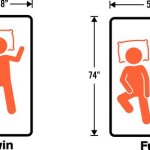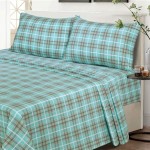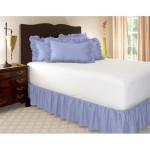How To Place a Rug Under a King Size Bed
Selecting and positioning a rug under a king-size bed offers a significant opportunity to enhance the aesthetic appeal and functionality of a bedroom. A properly placed rug can visually anchor the bed, add warmth and texture, and define the sleeping area within a larger space. However, successfully integrating a rug under a king-size bed requires careful consideration of dimensions, placement strategies, and the overall design scheme of the room. This article provides a comprehensive guide to navigating these factors to achieve a harmonious and well-designed bedroom.
Understanding Rug Size and King Size Bed Dimensions
Before exploring placement options, it is crucial to establish the standard dimensions of both king-size beds and common rug sizes. A standard king-size bed typically measures 76 inches wide by 80 inches long. However, variations can occur, especially with California king beds (72 inches wide by 84 inches long) or beds with substantial headboards or footboards. Always measure the bed frame itself to ensure accurate calculations.
Regarding rug sizes, the most common options for use with a king-size bed include 8x10 feet, 9x12 feet, and 10x14 feet. The ideal rug size depends on the desired visual effect and the amount of exposed flooring surrounding the bed. Smaller rugs, such as 8x10 feet, will generally cover the area under the bed and nightstands, while larger rugs, like 10x14 feet, can extend further into the room, creating a more expansive and luxurious feel.
Furthermore, consider the rug's pile height. A low-pile rug (e.g., a flatweave or tightly woven rug) is often preferable under a bed, as it will not obstruct the opening and closing of doors or create a tripping hazard. Thicker, high-pile rugs (e.g., shag rugs) can add a plush feel but may be better suited for smaller accent rugs placed beside the bed.
Exploring Different Rug Placement Strategies
Several viable placement options exist when integrating a rug under a king-size bed. The suitability of each strategy hinges on the room's dimensions, the rug's size, and the homeowner's aesthetic preferences.
The Two-Thirds Rule: This approach involves placing the rug so that it extends approximately two-thirds of the way under the bed, starting from the headboard and stretching towards the foot of the bed. The rug should extend beyond the sides of the bed, typically by 18 to 24 inches. This ensures that when stepping out of bed, feet land on a comfortable rug surface rather than a cold floor. This placement works well with 8x10 or 9x12 rugs in smaller bedrooms.
The Full Coverage Method: Opting for a larger rug, such as a 9x12 or 10x14, allows for complete coverage under the bed and nightstands. In this scenario, the rug typically extends 2-3 feet beyond the sides and foot of the bed. This approach can create a more luxurious and unified look, especially in larger bedrooms. It effectively defines the entire sleeping area and can visually expand the room. When using this method, ensure that the rug does not extend too far, potentially encroaching on walkways or obstructing doors.
The Partial Rug Placement: In smaller bedrooms or bedrooms with unusual layouts, a partial rug placement may be the most practical solution. This involves placing a smaller rug, such as a 6x9 or 5x8, at the foot of the bed. The rug extends a few feet beyond the foot of the bed and does not extend under the entire bed. This placement is primarily for aesthetic appeal and to provide a soft landing spot for feet when getting out of bed. This can also be a cost-effective solution if a large, expensive rug is not within budget.
Consider Nightstand Placement: An important consideration is whether to place nightstands entirely on the rug or to leave them off. Placing nightstands entirely on the rug creates a cohesive and unified look. However, if the nightstands are particularly large or the rug is smaller, placing some or all of the nightstands off the rug may be necessary to maintain balance and proportion. A general rule is to ensure that at least the front legs of the nightstands are on the rug to visually connect them to the bed and rug.
Addressing Practical Considerations and Design Principles
Beyond size and placement, several practical and design-related factors influence the selection and positioning of a rug under a king-size bed.
Room Size and Layout: Accurately measure the bedroom dimensions before selecting a rug. Consider the placement of other furniture, such as dressers, chairs, or benches. The rug should complement the overall layout and not impede traffic flow. In smaller rooms, a larger rug can make the space feel even smaller, whereas in larger rooms, a smaller rug may appear insignificant.
Rug Material and Texture: The choice of rug material impacts both aesthetics and functionality. Wool rugs are durable, stain-resistant, and offer a luxurious feel. Synthetic rugs, such as nylon or polypropylene, are more affordable and easier to clean, making them suitable for high-traffic areas. Natural fiber rugs, like jute or sisal, add texture and a natural element to the room but may be less forgiving with spills. The texture of the rug should complement the bedding and other textiles in the room.
Color and Pattern: The rug's color and pattern should harmonize with the overall color scheme of the bedroom. A neutral-colored rug, such as beige, gray, or ivory, can be a versatile choice that complements a wide range of decor styles. A patterned rug can add visual interest and personality to the room but should not clash with other patterns present. Consider the scale of the pattern in relation to the size of the room; larger patterns can overwhelm smaller spaces, while smaller patterns may get lost in larger rooms.
Underlayment: Utilizing a rug underlayment is highly recommended. An underlayment provides several benefits, including preventing the rug from slipping, adding extra cushioning, and protecting the flooring underneath. It also extends the lifespan of the rug by preventing excessive wear and tear. Choose an underlayment that is specifically designed for use with the type of flooring in the bedroom.
Maintenance and Cleaning: Consider the maintenance requirements of the chosen rug. Light-colored rugs may require more frequent cleaning than darker-colored rugs. Vacuum the rug regularly to remove dirt and debris. Address spills immediately to prevent staining. Professional rug cleaning may be necessary periodically to maintain its appearance and longevity.
Budget Considerations: Rug prices vary significantly depending on the material, size, and design. Establish a budget before beginning the selection process. Consider investing in a high-quality rug that will last for many years, rather than opting for a cheaper rug that may need to be replaced sooner. Explore options such as vintage rugs or sales to find affordable yet stylish options.
Accessibility: Ensure that there is adequate space around the bed and rug for easy movement. Avoid placing the rug in areas where it might create a tripping hazard. Pay close attention to the height of the rug, especially if there are doors or drawers that need to open freely.
Layering Rugs: For added visual interest and texture, consider layering a smaller rug on top of a larger rug. For example, a smaller sheepskin rug could be placed at the foot of the bed on top of a larger jute rug. This technique adds depth and dimension to the room. When layering rugs, ensure that the top rug is securely placed and does not pose a tripping hazard.
Lighting: The lighting in the bedroom can affect how the rug appears. Natural light will show the rug's true colors, while artificial light can alter the tones. Consider how the rug will look under different lighting conditions, especially at night. If possible, bring a sample of the rug home to see how it looks in the bedroom's lighting.
By carefully considering these factors, placing a rug under a king-size bed can transform the bedroom into a stylish and comfortable sanctuary.

Everything To Know About Placing A Rug Under Your Bed

Rug Under Bed Sizes King Queen Double Child Images

What Size Rug Should I Use Under A Bed Mcqueens Interiors

Pin On Dream Home

Rug Size Guide For King Beds With Pictures Popular Sizes

Rug Size Guide For King Beds With Pictures Popular Sizes

How To Find The Perfect Rug Size For Your King Bed According Pro Designers

What Size Is Suitable For The King Bed Rug Guide

What Size Rug Goes Under A Bed In My Own Style

How To Choose The Best Rug For Under Your Bed 136 Home








